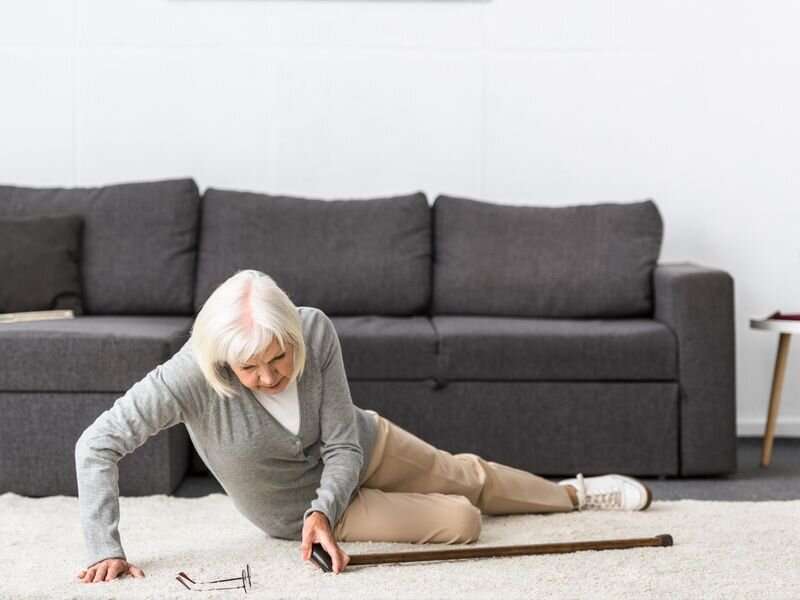This article has been reviewed according to Science X's editorial process and policies. Editors have highlighted the following attributes while ensuring the content's credibility:
fact-checked
peer-reviewed publication
reputable news agency
proofread
Rate of fatal falls among U.S. seniors doubled in 20 years

Older Americans are dying of falls at more than double the rate of 20 years ago—with women, men and all racial groups showing increases, according to a new study.
In 2020, the study found, just over 36,500 Americans age 65 and up died of a fall-related injury. That was up from roughly 10,100 deaths in 1999.
Adjusted for age, those numbers translated into a more than twofold increase in the rate of fall-related deaths among older Americans: from 29 per 100,000 in 1999, to 69 per 100,000 in 2020.
It's well known that falls are the leading cause of injury death among older Americans, and that the problem is growing.
The new findings underscore that, and show that no demographic is unaffected, according to researcher Alexis Santos-Lozada, an assistant professor of human development and family studies at Pennsylvania State University.
He found that fall-related death rates more than doubled among both women and men. Among racial and ethnic groups, white older adults had the highest death rate from falls, and the biggest increase—reaching 78 deaths per 100,000 in 2020.
But death rates also rose among Black seniors, Hispanic seniors, Asian seniors and Native American seniors alike.
"For every group, it's going in the same direction," Santos-Lozada said. "That's concerning."
Yet, he added, "fall prevention is not something we talk about a lot."
That's despite the fact that falls exact a huge health toll beyond the deaths they cause.
"Deaths from falls are just the tip of the iceberg," said Jennifer Tripken, associate director of the Center of Healthy Aging at the nonprofit National Council on Aging.
Far more older Americans take a fall every year, she said—many of whom do not tell their doctor, unless an injury forces them to seek care.
Figures from the U.S. Centers for Disease Control and Prevention tell the story: About one-quarter of older Americans fall each year. Roughly 3 million end up in the emergency room, and more than 800,000 have to be hospitalized—most often for a head injury or broken hip.
That translates to about $50 billion per year in medical costs, the CDC estimates.
The new study—published May 9 as a research letter in the Journal of the American Medical Association — cannot pinpoint the reasons for the rising death rate. Santos-Lozada analyzed national data on death rates from an online platform run by the CDC—which provides limited information based on death certificates.
But there are broad trends that are likely contributors, according to Tripken, who was not involved in the study.
For one, she said, more older adults these days are surviving serious medical conditions like heart attack and stroke—a good thing. But living with the aftereffects of those conditions can also put people at increased risk of falls.
Another factor, Tripken said, is that so many older adults now are taking multiple medications—some of which, or combinations of which, can cause dizziness or other side effects that contribute to falls.
In its fall prevention advice the CDC recommends that older adults ask their doctor or pharmacist to review their medications (including over-the-counter) to see if any may increase their risk of falls.
It's also important, Tripken said, for older adults to regularly have their eyesight and hearing checked, since impairments in either are risk factors for falls.
As for where older adults fall, other research shows that many do occur in medical or long-term care facilities, Santos-Lozada noted. But a large, and growing, proportion happen in the home, he said.
Tripken said that older adults and families can take a number of simple steps to make the home safer: Installing grab bars in bathrooms, getting rid of small throw rugs and other trip and slip hazards, having handrails on both sides of staircases, and making sure the house is well-lit are among them.
If possible, Tripken noted, older adults and families could work with an occupational therapist—health professionals who, among other things, can come to the home and recommend safety modifications.
More information: The National Council on Aging has a tool for older adults to check their risk of falls.
Alexis R. Santos-Lozada, Trends in Deaths From Falls Among Adults Aged 65 Years or Older in the US, 1999-2020, JAMA (2023). DOI: 10.1001/jama.2023.3054
Copyright © 2023 HealthDay. All rights reserved.





















